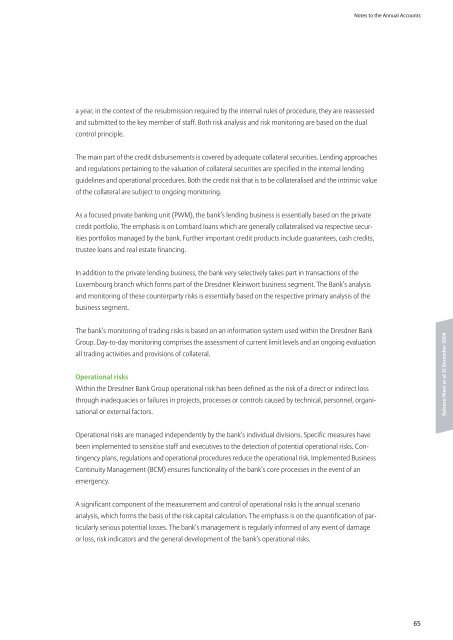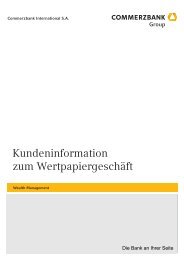Dresdner Bank - Commerzbank International SA
Dresdner Bank - Commerzbank International SA
Dresdner Bank - Commerzbank International SA
Create successful ePaper yourself
Turn your PDF publications into a flip-book with our unique Google optimized e-Paper software.
a year, in the context of the resubmission required by the internal rules of procedure, they are reassessed<br />
and submitted to the key member of staff. Both risk analysis and risk monitoring are based on the dual<br />
control principle.<br />
The main part of the credit disbursements is covered by adequate collateral securities. Lending approaches<br />
and regulations pertaining to the valuation of collateral securities are specified in the internal lending<br />
guidelines and operational procedures. Both the credit risk that is to be collateralised and the intrinsic value<br />
of the collateral are subject to ongoing monitoring.<br />
As a focused private banking unit (PWM), the bank’s lending business is essentially based on the private<br />
credit portfolio. The emphasis is on Lombard loans which are generally collateralised via respective securities<br />
portfolios managed by the bank. Further important credit products include guarantees, cash credits,<br />
trustee loans and real estate financing.<br />
In addition to the private lending business, the bank very selectively takes part in transactions of the<br />
Luxembourg branch which forms part of the <strong>Dresdner</strong> Kleinwort business segment. The <strong>Bank</strong>’s analysis<br />
and monitoring of these counterparty risks is essentially based on the respective primary analysis of the<br />
business segment.<br />
The bank’s monitoring of trading risks is based on an information system used within the <strong>Dresdner</strong> <strong>Bank</strong><br />
Group. Day-to-day monitoring comprises the assessment of current limit levels and an ongoing evaluation<br />
all trading activities and provisions of collateral.<br />
Operational risks<br />
Within the <strong>Dresdner</strong> <strong>Bank</strong> Group operational risk has been defined as the risk of a direct or indirect loss<br />
through inadequacies or failures in projects, processes or controls caused by technical, personnel, organisational<br />
or external factors.<br />
Operational risks are managed independently by the bank’s individual divisions. Specific measures have<br />
been implemented to sensitise staff and executives to the detection of potential operational risks. Contingency<br />
plans, regulations and operational procedures reduce the operational risk. Implemented Business<br />
Continuity Management (BCM) ensures functionality of the bank’s core processes in the event of an<br />
emergency.<br />
A significant component of the measurement and control of operational risks is the annual scenario<br />
analysis, which forms the basis of the risk capital calculation. The emphasis is on the quantification of particularly<br />
serious potential losses. The bank’s management is regularly informed of any event of damage<br />
or loss, risk indicators and the general development of the bank’s operational risks.<br />
Notes to the Annual Accounts<br />
65<br />
Balance Sheet as at 31 December 2008






